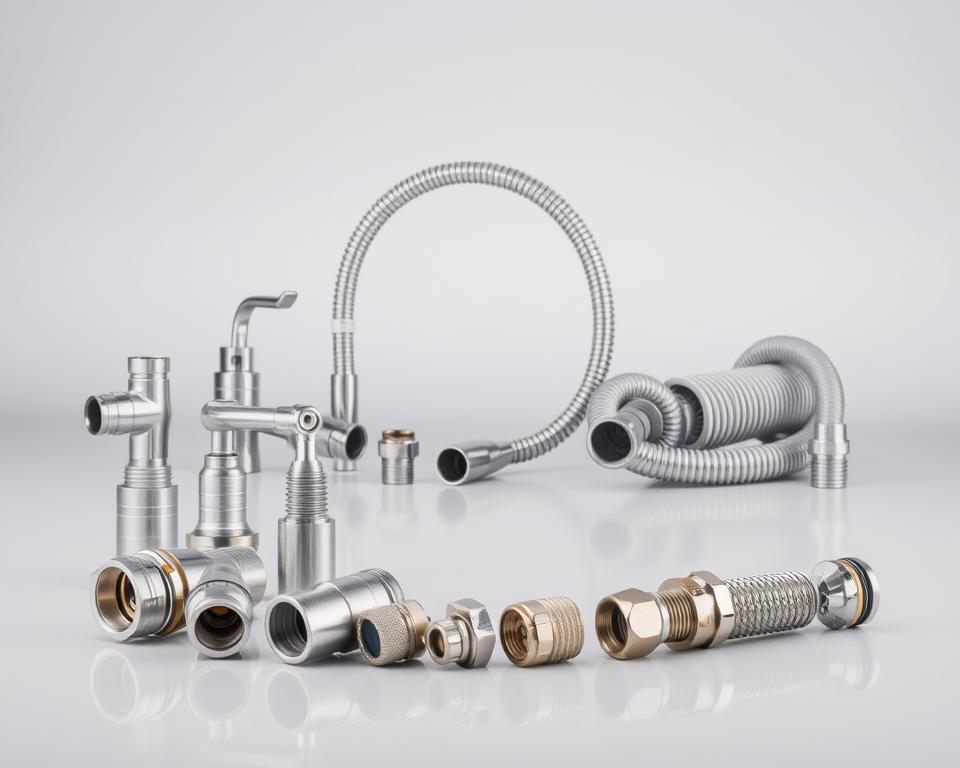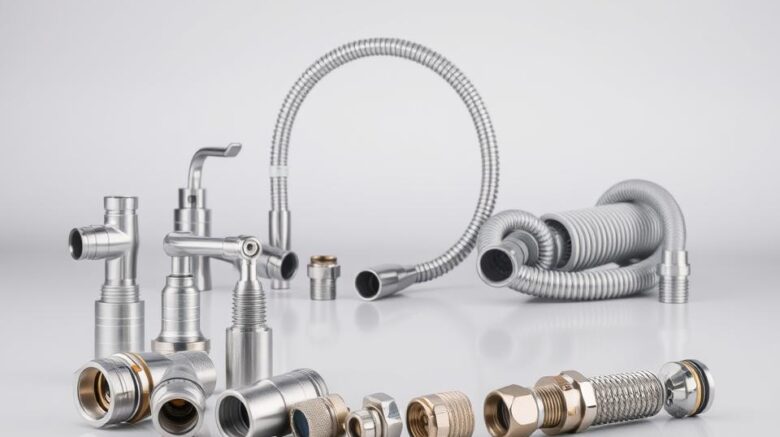Definitive Guide to Kitchen Sink Hose Connections
Have you realized attaching a kitchen sink hose attachment could cut down on your utility costs? Although the exact reductions vary, the inclusion holds value. A top-tier kitchen sink hose attachment boosts both performance and sustainability, enhancing any kitchen. This comprehensive handbook delves into their value, advantages, and how they transform regular kitchen tasks, such as veggie cleansing and dish cleaning.
Variants from 2016 and 2017 differ in durability and functionality. Irrespective of their production era, accurate setup is crucial; this typically requires removal of strainers or screens, a must in every instance. Regular upkeep is also essential to keep sink faucet connector in prime condition.
At Installation Parts Supply, we supply a variety tailored for different sinks, emphasizing longevity and usefulness. We will further explore the types, advantages, and maintenance for kitchen sink hose attachments.
Key Learnings
- Installing a kitchen sink hose attachment can lower water costs.
- Accurate installation ensures optimal operation; removing strainers is a vital step.
- Upkeep your hose attachment by routine cleaning.
- The type of material affects durability; PVC is prevalent but might bend improperly.
- Leak inspection following installation is essential for functionality.
- Using top-grade clamps enhances longevity and pressure tolerance.
- Explore selections at Installation Parts Supply for multiple kitchen needs.
Introduction to kitchen sink hose Add-ons
A kitchen sink hose attachment attaches to your faucet to simplify water flow control. They are offered in types like brass options and snap-on. This configuration boosts flexibility, enabling users to reach difficult areas effortlessly. An budget-friendly attachment boosts kitchen performance and streamline duties.
Defining a kitchen sink hose Attachment?
This attachment includes a bendable hose that channels water flow precisely to targeted locations. They are made from materials like brass and plastic, providing options for durability. Boasting both pull-out and pull-down styles, they work well for various applications. Among these are dish rinsing and washing produce.
Benefits of Utilizing a kitchen sink hose Attachment
Kitchen sink hose attachments offer a multitude of merits. They allow for versatile water flow regulation, optimizing spray patterns and direction. This adaptability aids in cleaning constricted spots or large objects. Installation is straightforward, requiring no professional help. With different cost ranges, locating a budget-friendly model is effortless, thereby improving your kitchen setup.
Varieties of kitchen sink hose Add-ons
Finding the right kitchen sink hose attachment is key to meeting your needs. Every model fulfills specific functions, complete with unique advantages. Familiarizing yourself with both pliant and stiff choices, alongside garden hose connectors, improves your kitchen’s functionality.

Flexible kitchen sink hose Devices
Flexible kitchen sink hose attachments provide incomparable versatility. Ideal for reaching difficult locations around the sink, they render rinsing dishes or rinsing fruits and veggies a breeze. Their flexibility to bend into restricted spots is highly valued. The popularity of these attachments is on the rise due to their functionality and simplicity.
Rigid kitchen sink hose Attachments
Rigid kitchen sink hose attachments are known for their stability, providing consistent water flow. They’re indispensable for filling containers or rinsing bulky objects with simplicity. Constructed from robust materials like stainless steel, they withstand wear and tear. They are favored by users for their ability to resist leaks, affirming their trustworthiness for daily use.
Adapters for Garden Hoses
Adapters for garden hoses connect kitchen faucets with outdoor hoses seamlessly. They serve as an asset in outdoor activities, from watering the garden to washing outdoor furniture. These adapters reduce manual work, saving homeowners from transporting heavy, water-filled buckets. By allowing most faucets to link with garden hoses, they provide wide versatility and convenience.
Selecting the Best kitchen sink hose Device
Choosing the right kitchen sink hose attachment involves considering multiple factors. These factors enhance both performance and usability in your kitchen space. It is vital to seek out products that ensure long-lasting performance and are made from high-grade materials. Installation simplicity and the fitting of the attachment with your sink are crucial for making the best choice.
Longevity and Build Quality
In your search for a long-lasting kitchen sink hose attachment, concentrate on the building materials. Options like stainless steel, granite, and top-quality plastics provide robustness. They are famous for their resistance to wear and tear. By choosing a durable option, you guarantee years of consistent operation, preserving its quality despite regular use.
Simple Setup
A kitchen sink hose attachment offering effortless setup facilitates the complete installation. Many models are designed for straightforward installation, intended for users without extensive DIY expertise. Select an attachment that features straightforward instructions and all the needed parts. This ensures a quick and hassle-free installation process.
Sink Compatibility
Confirming your kitchen sink hose attachment fits your sink is crucial. Most sinks feature pre-drilled holes for this purpose. You must opt for an attachment that complements your sink’s design. Proper compatibility eradicates issues such as leaks, so that your attachment operates perfectly.
Simple Setup of kitchen sink hose Attachments
Installing a kitchen sink hose attachment may appear difficult. Nonetheless, a straightforward set of instructions makes easier the process. This simple method guarantees anyone to upgrade their kitchen’s functionality. It outlines a comprehensive procedure for fitting a kitchen sink hose, including the required equipment.
Detailed Setup Instructions
Commence by collecting all required supplies and equipment. Employ an aerator removal tool to detach the faucet’s aerator. Check whether your faucet features male or female threads for proper connection. Apply Teflon tape around the faucet spout to ensure a tight, watertight seal.
Then, secure the correct faucet adapter. Confirm a firm attachment to prevent leaks. Install a rubber gasket for a secure seal; this should prevent any water leaks if done right. Apply vinyl grip tape on the wrench to prevent surface damage. Exercise extra care not to damage the threads, thereby avoiding harm to the faucet.
In scenarios without a vacuum breaker, incorporating a hose-type vacuum breaker is advisable for maintaining system integrity. Always release pressure from the hose before removal to stop water from splashing.
Required Tools
| Instrument | Use |
|---|---|
| Tool for Removing Aerators | To detach the aerator from the faucet |
| Teflon Tape | Wrap the faucet spout for a watertight seal |
| Adjustable Wrench | Ensure the faucet adapter is tightened without harm |
| Rubber Sealing Ring | Create a secure seal to stop leaks |
| Vinyl Adhesive Tape | Prevent surface damage while operating tools |
Upkeeping Your kitchen sink hose Device
To ensure your kitchen sink hose attachment operates efficiently and endures, regular maintenance is key. Through using proper cleaning methods and knowing when it’s time for a replacement, you can avoid larger complications over time.
Cleaning and Care Tips
Preserving the hygiene of your kitchen sink hose attachment is crucial for its performance. White vinegar (5-10% acetic acid) is excellent for dissolving scale buildup that can cause clogs. Here are some helpful cleaning tips:
- Submerge the sink sprayer cover in vinegar for a minimum of 1.5 hours to clean it thoroughly.
- In legacy models, disassemble the sprayer so as to immerse its parts like the pierced disk, covering sleeve, and seals.
- In modern versions, just twist the spray head in the reverse direction to easily reach its inside elements.
- A different approach for recent sprayer models is to submerge them in a bag filled with vinegar, making sure the sprayer is fully covered, for an identical period of 1.5 hours.
Because hard water minerals frequently cause sink sprayers blockages, routine cleaning is necessary for smooth operation.
Timing for Replacement of Your Hose Attachment
Knowing when to replace your kitchen sink hose is key to preventing plumbing headaches. Be alert to these signs:
- Frequent leaks indicate the hose material is deteriorating, signifying replacement is due.
- Noticeable fissures in the hose signal a decline in integrity.
- Lower water pressure might point to obstructions or impairments, indicating that replacement is necessary.
Proactive maintenance of your kitchen sink hose attachment greatly extend its longevity, keeping your kitchen running efficiently.
To Summarize
Adding a kitchen sink hose attachment substantially boosts your kitchen’s efficiency. Our detailed manual covered the types, merits, and upkeep recommendations of hose attachments. If you aim to improve your kitchen chores or revamp your area, a hose attachment provides flexibility and efficiency.
Such devices offer better thermal regulation and water flow. They make clearing food remnants effortless, ensuring a pristine space. Their benefits in daily kitchen operations are unquestionable, enhancing your cleaning routine considerably.
Enhancing your kitchen can be simpler and more affordable than expected. With options for every budget and design preference, a kitchen sink hose attachment could radically change your kitchen environment. Opting for high-quality selections, like those from Installation Parts Supply, you ensure long-lasting use and happiness.
Frequently Asked Questions
What is a kitchen sink hose attachment?
A kitchen sink hose attachment links to your faucet, turning it into a water sprayer. This adjustment boosts water usage flexibility. It streamlines activities such as washing and plant care.
What is the process for installing a kitchen sink hose attachment?
When setting up, first remove your faucet’s aerator. Then attach the correct faucet adapter. Ensure every connection is secure and watertight. An adjustable wrench and Teflon tape are typically required an adjustable wrench and Teflon tape.
What factors matter when choosing the best kitchen sink hose attachment?
While picking, focus on robustness, construction standards, installation simplicity, and compatibility with your sink and faucet. Using stainless steel or premium plastics offer more durability.
Is it true that kitchen sink hose attachments are simple to care for?
Yes, they are easy to maintain. Employ vinegar for cleaning to remove mineral deposits. Periodically examine for leaks and clogs. Replace the attachment if it cracks, leaks, or restricts water flow.
Can I use a kitchen sink hose attachment for outdoor tasks?
Certainly, by attaching it to garden hoses with adapters, it’s perfect for outdoor chores like garden watering.
Can I find budget-friendly kitchen sink hose attachments?
Indeed, the market features numerous cost-effective selections. Installation Parts Supply supplies a variety that balances cost with quality.
How do flexible and rigid hose attachments differ
Flexible hose attachments can curve to access challenging angles, enhancing adaptability for multiple applications. Non-flexible hose attachments keep their form, providing stable water flow trajectory. They tend to be more durable.
